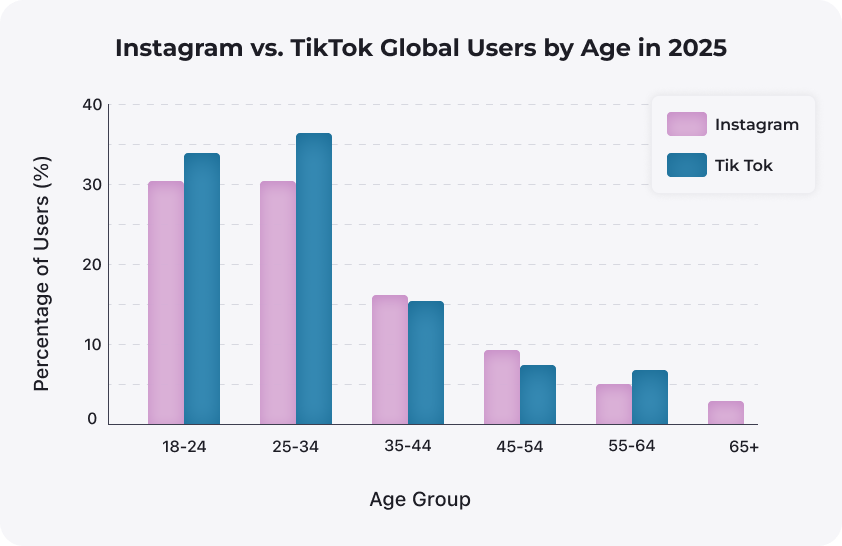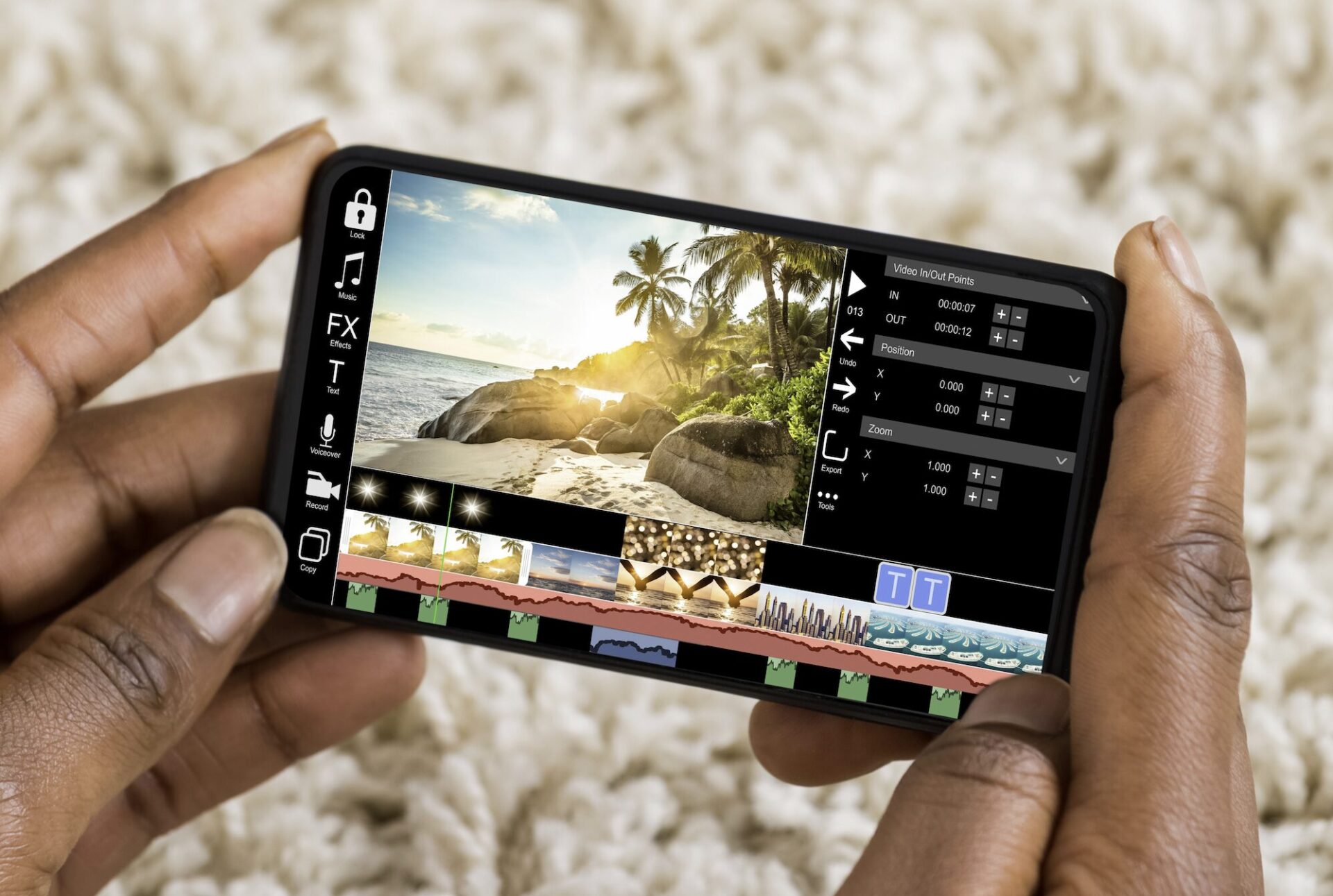TikTok vs. Instagram: Key Differences to Help You Choose a Perfect Platform to Go Viral

Instagram and TikTok have dozens of similar features – short-form videos, live streams, and a personalized algorithm, just to name a few. However, when it comes to social media marketing, any seasoned specialist will tell you just how different the two platforms are. And as a content creator, you should be aware of the differences to make an informed choice in this everlasting TikTok Vs. Instagram rivalry.
The truth is, you don’t have to stick to only one or the other. When it comes to TikTok versus Instagram, they each have unique strengths that make them suitable for different purposes and content types. Here’s a complete guide to the pros and cons of TikTok and Instagram from the creator’s point of view. We’ll walk you through the perks of the algorithms of these social media platforms, audience demographics, ad formats, and best content types – everything you should consider to go viral quickly and with minimum effort.
Table of Contents
TikTok vs. Instagram: A Quick Overview
Instagram and TikTok are two of the most influential social media platforms today, but they weren’t always direct competitors. While they now share similar features like short vertical videos and personalized content recommendations, their origins, and core purposes were quite different in the beginning.
A Brief History of TikTok and Instagram
Instagram was launched in 2010 as a photo-sharing app, quickly gaining popularity for its aesthetically pleasing filters and simple user interface. Over time, it evolved into a multi-purpose social platform, introducing Instagram Stories, carousels, and later, Reels to keep up with changing content trends. Today, Instagram is a hub for personal branding, influencer marketing, and e-commerce, with multiple content formats for every purpose.
TikTok, on the other hand, was built specifically for short-form video content. Originally launched as Douyin in China in 2016, its international version, TikTok, quickly gained traction, especially among younger audiences. Unlike Instagram, which started with static images, TikTok’s entire experience revolves around video content, which, given the current trends in content, makes it one of the fastest-growing platforms in social media history.
How They’ve Shaped Modern Social Media Trends
Both TikTok and Instagram have played key roles in shaping online content trends. Instagram popularized influencer culture, as well as aesthetics and visual appeal in content, encouraging users to curate visually appealing feeds. It also helped businesses and creators establish long-term brand identities through consistent content and engagement.
TikTok brought along a revolution in the way people consume and create content by emphasizing short, engaging, and often unpolished videos. The app’s “For You” page, powered by a highly responsive algorithm, allows even new creators to go viral overnight, making TikTok a go-to platform for organic reach.
While both platforms are now competing in the video space, their distinct features and user behaviors make them suited for different types of content. Understanding these differences will help you decide which one aligns best with your goals as a creator and choose the best option for your content. Let’s break down the key differences between these platforms one by one.
Audience Demographics: Who’s Watching Your Content?
One of the biggest differences between TikTok and Instagram is their target audience. While both platforms attract millions of users worldwide, their demographics, behaviors, and engagement levels vary significantly.
Age Groups and User Behavior
TikTok is known for its younger user base. The majority of its audience falls within the 18-24 age range, with a strong presence of Gen Z users. This makes TikTok an ideal platform for trends, viral challenges, and fast-moving content that appeals to younger generations. The platform also encourages a more casual and interactive style of engagement, where authenticity often outperforms overly polished, high-quality content.
Instagram users, on the other hand, fall into a broader age range, with a strong presence of both Millennials and Gen Z. While younger users are still active on Instagram, the platform also attracts users in their late 20s, 30s, and even older demographics. This makes it a great platform for creators and businesses targeting a more mature audience with content that balances entertainment, lifestyle, and professionalism.

Geographic Reach and Global Influence
Both Instagram and TikTok have massive global audiences, but their reach differs slightly by region. TikTok is extremely popular in countries like the U.S., China, Indonesia, and Brazil, while Instagram has a stronger foothold in North America, Europe, and parts of Asia. Depending on your target market, one platform might offer better exposure in certain countries.
Engagement Rates: Which Platform Drives More Interaction?
When it comes to engagement, TikTok has the upper hand. Thanks to TikTok’s algorithm-driven content discovery, even new creators can gain thousands or even millions of views with the right video. TikTok users spend an average of over 90 minutes per day on the app, scrolling through content. This high level of engagement increases the chances of your videos being seen and shared.
Instagram’s algorithm, while still being highly engaging, operates differently. Content is shown based on a mix of follower interactions, relevant hashtags, and the Explore page algorithm. This means creators often need a larger following or consistent engagement to gain organic reach. However, Instagram users tend to be more brand-conscious and are more likely to engage with professional, curated content.
Which Platform Is Best for You?
If your target audience is Gen Z and you’re looking for fast organic reach, you can leverage TikTok to your advantage. If you’re aiming for a more diverse age range, professional branding, or long-term content growth, Instagram might be a better platform. However, many successful creators use both, tailoring their content strategy to each audience for maximum reach.
Content Formats & Features: What’s Best for Your Creativity?
Both TikTok and Instagram offer a variety of content formats, but they serve different purposes. Whether you’re a creator looking to go viral or a brand trying to engage your audience, understanding these differences will help you make the most of each platform’s features.
Short Videos: TikTok Vs. Instagram Reels
The biggest similarity between TikTok and Instagram is their focus on short-form videos. TikTok videos can range from a few seconds to 10 minutes, but the sweet spot is 15 to 60-second-long clips. The algorithm prioritizes engaging, fast-paced clips that capture attention immediately, making it ideal for trends, challenges, and viral moments. TikTok also offers a vast library of trending sounds, special effects, and editing tools that encourage creativity and experimentation. You can also upload your own audio as long as it complies with the platform’s terms and conditions, and the audio itself can go viral, gaining you recognition and increasing your follower count.
Instagram’s answer to TikTok, Reels, works similarly but with some key differences. Reels can be up to 90 seconds long, and while Instagram provides filters, text overlays, and music options, its editing features are not as advanced as TikTok’s as of now. However, Instagram Reels benefit from integration with the broader Instagram ecosystem – your videos can appear on the Explore page, in Instagram Stories, and even on your main feed. This makes it easier to repurpose content for different audiences.
Stories, Carousels, and Other Image-Related Features
One major advantage of Instagram over TikTok is its diverse content formats beyond videos. Instagram allows users to share Stories – 24-hour disappearing posts that can include images, videos, polls, and links. This feature is widely used for behind-the-scenes content, daily updates, and direct audience interaction. TikTok, in contrast, only recently introduced Stories, and they are not as widely adopted by users.
Another format Instagram excels at is carousel posts, where creators can share multiple images or videos in a single swipeable post. This is particularly useful for educational content, product showcases, and storytelling, offering more depth than a single image or video. TikTok offers carousel posts too, but the online community still turns to its video features for informative, educational, and entertaining content alike.
Live Streaming and Community-Building Tools
Both TikTok and Instagram offer live streaming, but they cater to different audiences and user interests. Instagram Live is popular among influencers, brands, and professionals who use it for Q&A sessions, collaborations, and product launches. It also allows multiple users to go live together, making it a great tool for interviews and discussions.
TikTok Live, on the other hand, is more focused on entertainment and engagement. Many creators use it for real-time interactions, live Q&A sessions, and even monetization through gifts from viewers. TikTok’s algorithm also pushes live streams to a wider audience, making it easier to gain new followers through live content.
Which Platform is Better for Content Creation?
If your main focus is short-form video and fast-paced viral content, TikTok provides better tools and exposure. If you prefer a more versatile content strategy that includes Stories, carousels, and long-form posts, Instagram offers a wider range of formats to engage your audience.
Many successful creators use both platforms strategically. They utilize TikTok for organic reach and viral trends while using Instagram for brand-building and deeper audience engagement. The key is understanding how to create content to match each platform’s strengths for maximum impact.
Boost Your Content Discovery and Go Viral with Dubs
With the right tools, you can create content that engages and attracts with ease. AI tools have been the go-to solution for content creators lately – they take over the routine tasks, freeing your time and resources for creative expression. Dubs is a video content suite that features all the necessary tools to make organic content that gains maximum impressions. Add highly accurate automatic subtitles, create captions to aid your visual storytelling, leverage video editing tools for smooth transitions, and adapt your content for various ad formats in a few clicks. Try the Dubs app now, and watch your content bloom.
Which App Is Better for Influencer Marketing and Selling?
TikTok for Marketing and Selling
TikTok’s video-based platform and high levels of engagement make it a great place to promote products. You can go viral – and reach more people – more easily here than on Instagram, especially if you follow TikTok trends. When you align your content with what’s popular, TikTok is more likely to show your content to a broader audience, which is ideal for marketing.
Another point to consider is the age of your target audience. As we said before, TikTok users tend to fall into the age range of 18-24, making it a perfect platform for selling to younger audiences.
There is also a Shop feature that lets TikTok users buy items directly from the app. They can find and buy products in four places: in-feed videos, live streams, profile showcases, and the shopping tab on users’ homepages. This means there are more opportunities for people to purchase something.
Instagram for Marketing and Selling
Instagram is a highly competitive platform when it comes to e-commerce. It has existed for longer, so it has more selling opportunities in place, like several ad formats, shoppable Instagram ads, in-post product tags, and Reels product tags.
Instagram also has a Creator Marketplace that lets influencers and brands connect, so if you’re a content creator looking for sponsorships, they might be easier to find on Instagram. You can also use in-feed ads in the forms of posts, Stories, and Reels for sponsored content instead of just TikTok videos.
The main drawback is that there’s quite a lot of e-commerce activity on Instagram, which means it’s hard to stand out as an influencer. To market a product successfully, you have to pay extra attention to making quality content that entertains, informs, or educates the audience. Instead of feeling like you’re just trying to market something, viewers can connect with your content.
Which Platform Should You Choose? Final Verdict
With both TikTok and Instagram offering powerful tools for content creation and growth, choosing the right platform depends on your goals, audience, and content style. Here’s a breakdown to help you decide.
Best Platform for Personal Branding
If you want to build a personal brand and create a recognizable online presence, Instagram is the better choice. Instagram allows you to showcase your personality, lifestyle, and expertise through a mix of Reels, Stories, carousel posts, and live sessions. The platform also offers stronger networking opportunities, making it easier to connect with brands and fellow creators for long-term collaborations.
TikTok, however, is great for growing quickly and gaining visibility, especially if you are a micro-influencer and create content that aligns with trends. While it may be easier to go viral with just one video, audience retention can be lower since users often consume content passively without following individual creators.
Best Platform for Business & Product Promotion
For businesses and entrepreneurs, Instagram provides better tools for product promotion and e-commerce. Features like Instagram Shopping, clickable links in Stories, and a professional business dashboard make it easy to turn followers into customers. If you’re selling a product or service, Instagram offers a more structured marketing approach.
TikTok, on the other hand, is excellent for brand awareness. It’s ideal for businesses that want to create buzz, launch viral campaigns, or target younger audiences with engaging and informal content. However, direct conversions and sales may require additional efforts outside of TikTok.
Hybrid Strategy: Why Not Both?
Many successful creators and brands use both TikTok and Instagram together. The two platforms can complement each other, driving even better reach and engagement. TikTok is great for quick exposure and viral moments, while Instagram helps build deeper relationships and long-term engagement. If possible, repurpose content and tailor it for each platform to maximize your reach.
More articles

150+ Best Vacation Instagram Captions to Make Your Travel Photos Pop
Planning your dream vacation is exciting, but finding the perfect words to accompany those stunning photos can be challenging. Whether you’re lounging on a tropical beach, exploring ancient ruins, or hiking breathtaking mountains, the right caption can elevate your Instagram post from ordinary to unforgettable. You’ve packed your bags for the family vacation, created memories, […]

175+ Unforgettable Prom Instagram Captions to Make Your Night Shine | 2025 Edition
Capturing the magic of prom night on Instagram requires more than just stunning photos – you need the perfect caption to complete your post. Whether you’re looking for something sentimental, funny, referencing your favorite song lyrics, or the photos from the dance floor, the right words can make your prom memories shine even brighter on […]

200+ Beach Instagram Captions: From Funny to Inspirational Quotes
Looking for the perfect words to pair with your beach photos? You’re not alone. A day at the shore isn’t truly complete until you’ve captured those sun-soaked moments and shared them with a caption that perfectly complements your vibe. Whether you’re posting golden hour selfies, documenting beach games, or showcasing those “sunkissed nose, sandy toes” […]